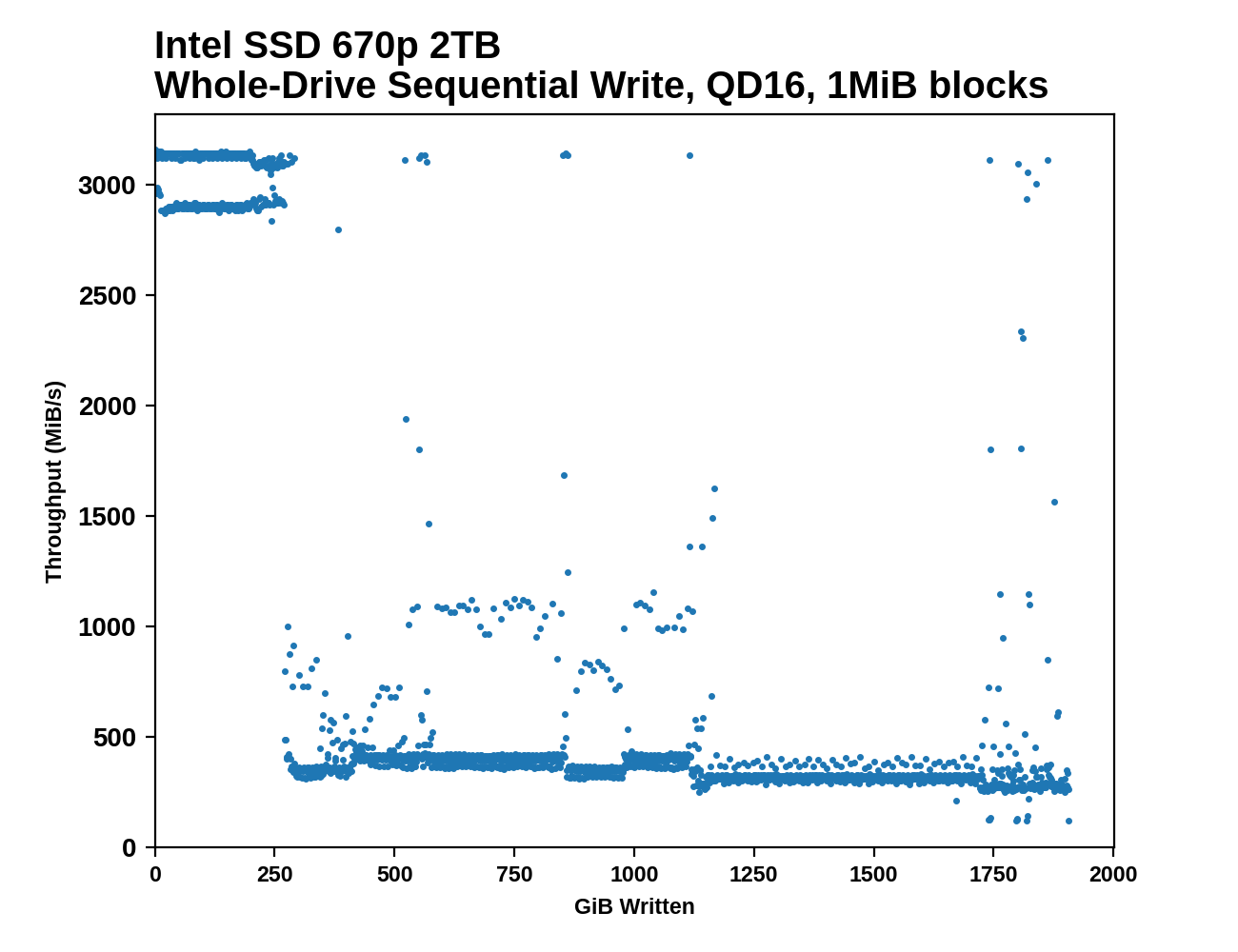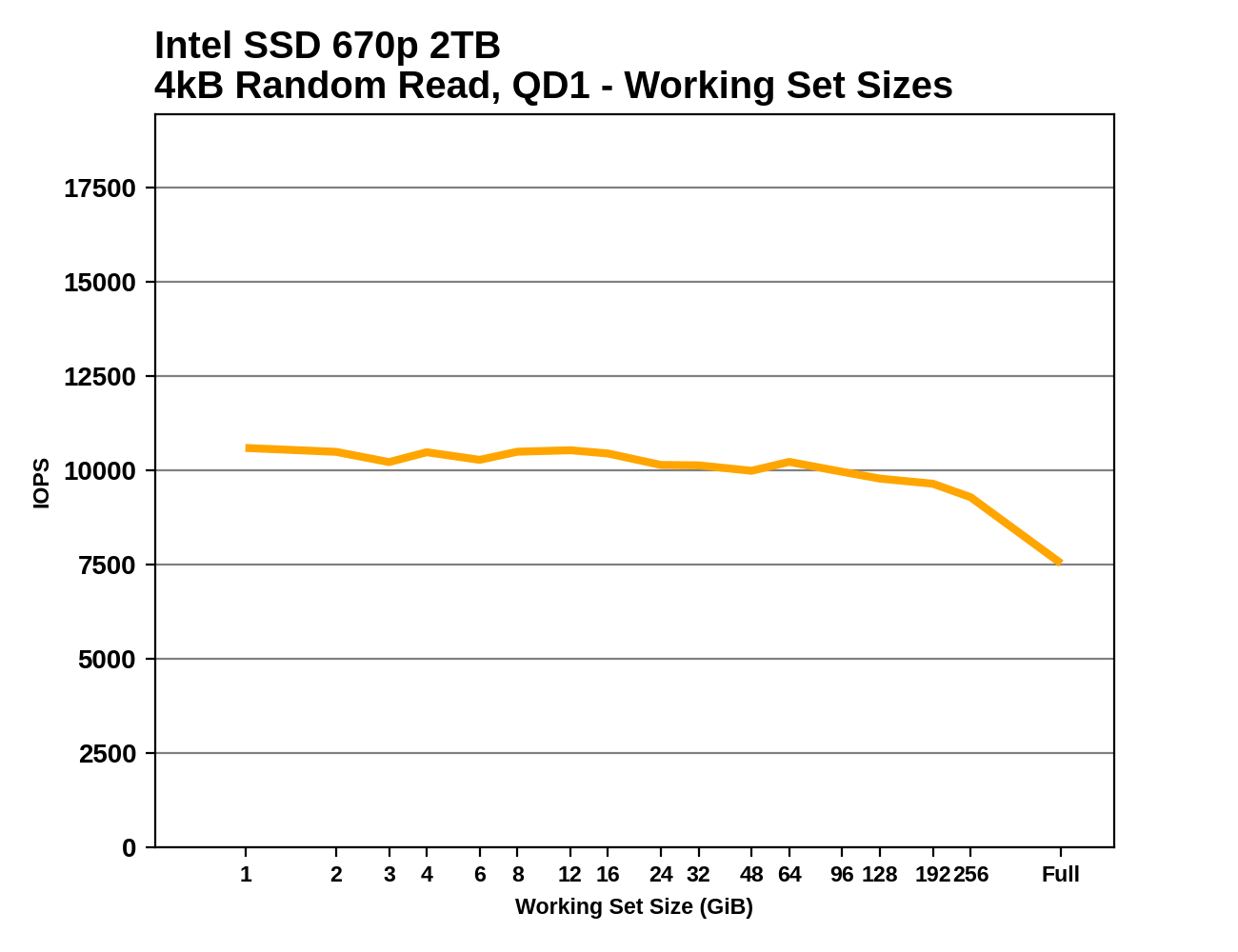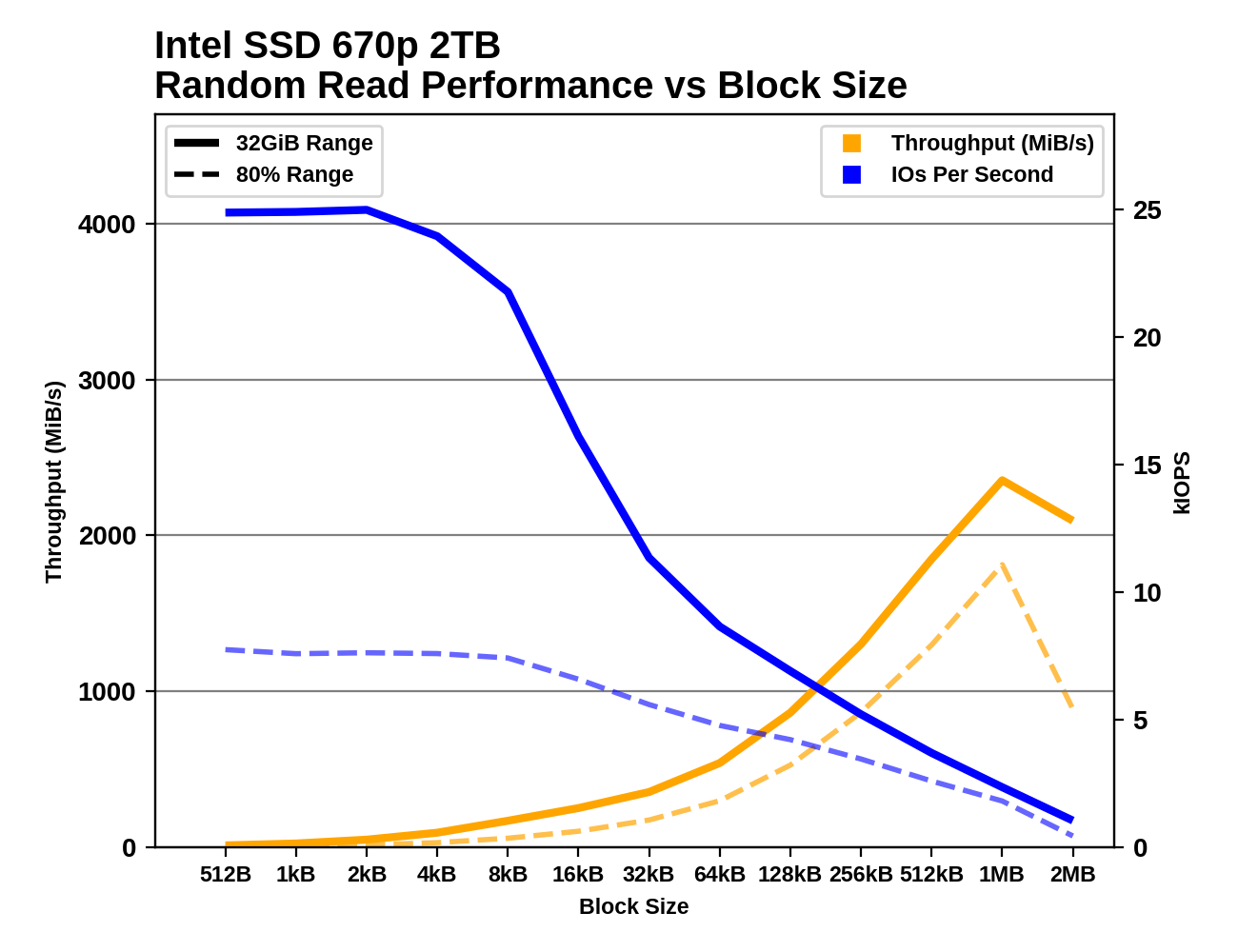The Intel SSD 670p (2TB) Review: Improving QLC, But Crazy Pricing?!?
by Billy Tallis on March 1, 2021 12:00 PM ESTAdvanced Synthetic Tests
Our benchmark suite includes a variety of tests that are less about replicating any real-world IO patterns, and more about exposing the inner workings of a drive with narrowly-focused tests. Many of these tests will show exaggerated differences between drives, and for the most part that should not be taken as a sign that one drive will be drastically faster for real-world usage. These tests are about satisfying curiosity, and are not good measures of overall drive performance. For more details, please see the overview of our 2021 Consumer SSD Benchmark Suite.
Whole-Drive Fill
 |
|||||||||
| Pass 1 | |||||||||
| Pass 2 | |||||||||
The Intel SSD 670p shows less consistent performance than the 660p during the sequential drive write. Writing to the SLC cache bounces between two performance levels, just above and just below 3 GB/s. The cache runs out more or less on schedule and performance drops down into SATA territory with sporadic outliers that are faster than normal. There's a bit of a stepped downward trend in performance as the drive approaches full. On the second pass that overwrites data on a full drive, the 670p is even more inconsistent with short bursts up to SLC write speed throughout the process.
 |
|||||||||
| Average Throughput for last 16 GB | Overall Average Throughput | ||||||||
The overall average write speed of the 670p is now almost enough to saturate a SATA interface. At the tail end of the filling process it does dip down to hard drive speeds, but any large sequential transfer of data onto the 670p will definitely complete more quickly than any one hard drive can handle. The controller upgrade helps some here (primarily with the SLC cache write speed), but for the most part the NAND itself is still the bottleneck, which means the smaller capacities of the 670p will not perform as well.
Working Set Size
 |
|||||||||
Intel is still clearly using a reduced DRAM design with the 670p rather than the full 1GB per 1TB ratio that mainstream SSDs use. The drop in performance at large working set sizes closely mirrors what we saw with the 660p, albeit with higher performance across the board thanks to the lower latency of the 144L NAND.
Performance vs Block Size
 |
|||||||||
| Random Read | |||||||||
| Random Write | |||||||||
| Sequential Read | |||||||||
| Sequential Write | |||||||||
With the 670p, Intel has eliminated the IOPS penalty that random reads smaller than 4kB suffer on the 660p, but that effect is still present for random writes. The IOPS difference between the short-range tests that hit the SLC cache and the 80% full drive tests is bigger for the 670p than the 660p; the newer drive has generally improved performance, but is in some ways even more reliant on the SLC cache.
Sequential throughput on the 670p keeps increasing with larger block sizes, long past the point where the 660p saturated its controller's limits. The performance trends for both sequential reads and writes are well-behaved with little disparity between the short-range tests and the 80% full drive tests, and no indication of the SLC cache running out during the sequential write tests.










72 Comments
View All Comments
Spunjji - Thursday, March 4, 2021 - link
That's good for you, but your opinion is such garbage that even Samsung no longer agree. High-performance TLC drives now outperform the best MLC had to offer, and while you could argue that MLC with the same tech would be faster, the cost involved would make it impossible to sell to anyone outside of the Enterprise market.bug77 - Tuesday, March 2, 2021 - link
Fwiw, first TLC drives (planar) had about the same endurance as these QLC V-NAND drives. So yeah, same reluctance.Wereweeb - Tuesday, March 2, 2021 - link
Planar TLC is as bad as today's 3D QLC, so no wonder people are criticizing it for roughly the same reasons. The difference is that the NAND cells of 3D flash are much larger, so they can handle both many more electrons and much more wear. Shrink those 3D cells, and QLC can become as bad as we imagine PLC will be.Tomatotech - Tuesday, March 2, 2021 - link
QLC gets much better at higher densities. The 4TB/ 8TB QLC drives are looking pretty good.Don't forget a good QLC drive will fold empty space into fast SLC storage. An empty 4TB QLC will give you 1TB SLC. A half full 4TB QLC drive still has about 500GB of SLC tier space available.
FunBunny2 - Tuesday, March 2, 2021 - link
"I refuse out of principle to ever purchase a QLC drive."well... once the vendors decide that they won't manufacture anything less dense, then what?
powerarmour - Tuesday, March 2, 2021 - link
Simple, they get one less sale from me.FunBunny2 - Thursday, March 4, 2021 - link
"Simple, they get one less sale from me."the problem is: in due time xLC NAND simply won't exist because the vendors refuse to make any. or if they do, it will be only for niche OEMs or the likes of Google who buy out a year's worth of production. even then, the Enterprise world simply retires stuff at warranty and buys more. not a problem for them, since they get to write off the costs to the American Taxpayer. one might expect QLC/PLC(should it ever exist) SSD to have a warranty that lasts a blink of an eye.
brucethemoose - Monday, March 1, 2021 - link
As brands, Intel and Samsung are worth top dollar. I've seen many online discussions where some shockingly overpriced SSDs are recommended, either for "reliability," or without any justification or alternatives being presented.In other words, I suspect the 670p will sell just fine at that price.
ZolaIII - Monday, March 1, 2021 - link
It won't sell or better said you won't have choice when OEM's stick it up to you.ZolaIII - Monday, March 1, 2021 - link
With such products and prices it's good that they are leaving the market. For less you can get much much better TLC M2 which runs around this in circles regarding performance.